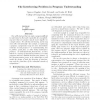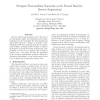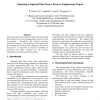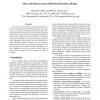WCRE
1995
IEEE
14 years 4 months ago
1995
IEEE
One of the factors that can make a program di cult to understand is that code responsible for accomplishing more than one purpose may be woven together in a single section. We cal...
WCRE
1995
IEEE
14 years 4 months ago
1995
IEEE
A legacy system is an operational, large-scale software system that is maintained beyond its first generation of programmers. It typically represents a massive economic investmen...
WCRE
1995
IEEE
14 years 4 months ago
1995
IEEE
Reverse engineering of program code is the process of constructing a higher level abstraction of an implementation in order to facilitate the understanding of a system that may be...
WCRE
1995
IEEE
14 years 4 months ago
1995
IEEE
WCRE
1995
IEEE
14 years 4 months ago
1995
IEEE
Several processes have been advanced in the literature for reverse engineering of relational databases. The inputs to these processes are relational tables and available contextua...
WCRE
1995
IEEE
14 years 4 months ago
1995
IEEE
This paper describes how a program called dup can be used to locate instances of duplication or nearduplication in a software system. D u p reports both textually identical sectio...




